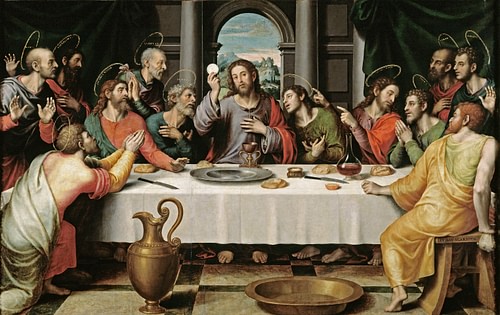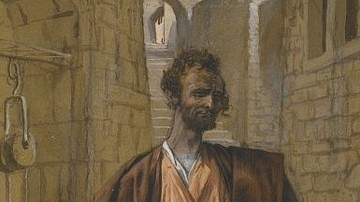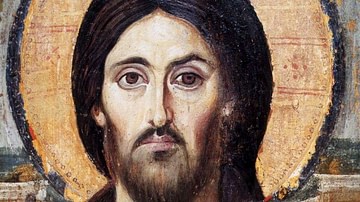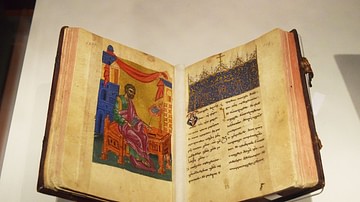The only sources for the life of Jesus of Nazareth are in the canonical gospels (or the gospels that were included in the authorised version of the New Testament). We have no contemporary, eyewitness testimony from the time that he lived and preached in Israel. The earliest gospel, Mark, was written approximately in the year 65 or 70 CE , followed by Matthew, Luke, and John. The letters of Paul, the earliest evidence of the Christian movement, were written in the 50's and 60's CE but contain very little in terms of the “historical Jesus." This is a synopsis of the events reported in the four gospels:
Sometime during the 20's of the Common Era, an itinerant preacher known as Jesus, emulating the style of the prophets of ancient Israel, began addressing crowds in his native area, mainly the Galilee region of Northern Israel. He may have been in the circle attached to a popular religious reformer known as John the Baptist and it appears that he took up the same message after John's death. His basic message was, “Repent, for the Kingdom of God is at hand!” What he meant by this was that God would soon intervene one last time in history and restore the nation of Israel whose populace would now live in an ideal kingdom, on earth, as God originally intended before the “fall” in the Garden of Eden (see Genesis). It appears from the first three gospels (Mark, Matthew, and Luke), that his preferred method of instruction was the use of the “parable,” a short, pithy, story which makes use of simple situations and characters to illustrate or illuminate higher, more abstract, concepts such as forgiveness, altruism, or one's relationship with God.
According to the earliest gospel, Mark, he was also noted for miracles: curing diseases, raising people from the dead, exorcisms, or the removal of “demons,” and other seemingly miraculous feats such as the multiplying of the loaves and fishes and walking on water. He gathered disciples (students, followers) around him, in the symbolic number of “twelve” (reflecting the twelve tribes of Israel). While drawing the countryside to his message, Mark reports a constant harassment and persecution by specific groups of Jews, namely the Pharisees and the scribes and, eventually, the Sadducees. This last group was largely responsible for the maintenance and upkeep of the Temple in Jerusalem. In the gospels, the Pharisees consistently accused Jesus of “violating the Law of Moses,” but the gospel writers specifically deny that he challenged the customs of the Jews, claiming he merely offered what they understood as the “true” interpretation of this Law and the traditions associated with it..
In Mark, Matthew, and Luke, Jesus spends most of his time moving around the Galilee, and then he makes a final trip to the city of Jerusalem during the holiday of Passover (when all Jews were expected to try to make a pilgrimage to that city). In John, Jesus makes several trips to Jerusalem throughout his ministry.
When Jesus enters the city, the crowds use palm branches to welcome him, and proclaim him the “messiah,” or “anointed one". The gospel writers make clear in this that the crowd hailed him as a descendent of the line of King David and in so doing, add a political element to Jesus' ministry as evinced in the title accorded him as “King of the Jews”. This event, his triumphal entrance to Jerusalem, is the basis for the Christian observance of “Palm Sunday,” a week before Easter. As soon as Jesus enters the city, he goes to the outer court of the Temple and drives out the men who were selling animals for the sacrifices, as well as the men in charge of money-changing tables, claiming, “My house shall be a house of prayer for all the nations, but you have made it a den of thieves.” According to Mark, it is this incident that directly leads to the death of Jesus.
Jesus and his disciples celebrate a Passover meal on Thursday evening (Mark, Matthew, Luke), or a simple meal on Wednesday evening (John), where the tradition of the ritual known as the “last supper” takes place. This event will later become the basis for the Christian celebration of the “eucharist,” or communion meal through the letters of the apostle Paul. Jesus, for the third or fourth time, predicts his own death, but claims that he will overcome it, as the “kingdom” takes over. After dinner, he and his followers go over to the Mount of Olives, to an olive oil press area known as “Gethsemane,” and Jesus prays that God will spare him his impending torture and death. The gospels do not record any answer from God and Jesus willingly accepts his fate.
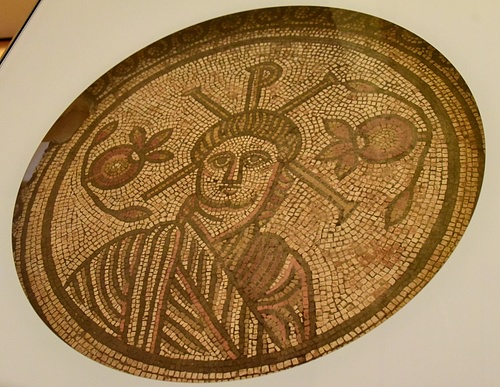
One of the disciples, Judas, betrays Jesus by telling the priests/temple captains/and or Romans (depending upon which gospel one is reading) where he will be that evening and Jesus is arrested. He is either taken to a meeting of the whole Jewish city council, or to the high-priest's house (John). A very confusing “trial” follows, where the charges are not clear (and there is variation in the number of trials and their location). Finally, in Mark, the high-priest asks Jesus if he is “the Blessed One” (meaning the “messiah”). Jesus, reticent up until this moment in Mark, answers that he is “the Son of Man,” whom tradition holds would judge mankind in the “final days,” or the time right before the “Kingdom.” At this, the high-priest claims that he has committed blasphemy, and he is condemned to death.
In the 1st century CE, the Jewish council could not enforce a death sentence and this is why we are told that Jesus is sent to Pontius Pilate, the regional governor from Rome of the Judean province which included Jerusalem. In the gospels, Pilate is portrayed as a weak, powerless ruler, who gives in to the Jews and condemns Jesus to death by crucifixion (the Roman punishment for treason which was meted out owing to the claim that Jesus was “King of the Jews”). Jesus is then scourged and sent with his cross to the place of execution, outside the city walls. According to Mark, all of his male disciples abandon him, but the women look on as witnesses. It takes Jesus about three or four hours to die. This was on a Friday, and Friday sunset began the “Sabbath,” or the Jewish day of rest. Following his death, therefore, there is narrated a hurried attempt to remove the body from the cross and prepare it for burial before sundown since religious tradition held that one could not engage in such tasks on the sabbath.
Because Saturday was the holy day of the sabbath, no one could visit the tomb to complete the funeral rites (anointing with oil, etc.), so Sunday morning, the women came to the tomb to finish their ministrations. According to Mark, the women find the tomb empty, but in the other gospels an angel tells them that Jesus rose from the dead and that they should tell everyone to meet him in Galilee. There is no resurrection scene in Mark (whose original ending is an empty tomb) while Matthew and Luke have actual resurrection appearances by Jesus and John adds several more of these appearances to the story. This is the basis for the Christian holiday known as “Easter Sunday” “Easter” is derived from the Teutonic language of Europe, designating the fertility goddess, “Eostre”.
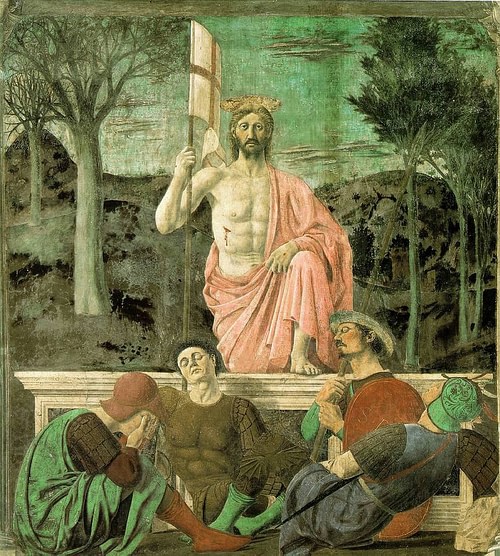
The crucifixion/resurrection of Jesus became the basis of the Christian concept of "atonement," or the concept that Jesus willingly gave up his life so that human beings could be "saved." The general understanding is that Jesus died to "save us from our sins," or in other words, with his death, mankind can now achieve "forgiveness." The concept of atonement, per se, is not mentioned specifically in the gospels. Mark, Matthew, and Luke claim Jesus died for the “sins” of the people but do not speficy what those sins are; John states the death of Jesus was the means to get him “home” to the “Father” [God]. The concept of “atonement,” as understood in Christianity, is actually a concept first developed by the apostle Paul in his Letter to the Romans.
While absent in the earliest gospel of Mark, the narratives of Matthew and Luke add what are known as the nativity of Jesus, or the details of the birth of Jesus in the city of Bethlehem. Matthew introduces the Star which guides the Magi, or “wise men”, from the east who visit the newborn, while Luke adds the details of the manger (a feeding trough for animals) in a stable and the shepherds in the fields who come to worship the child. These elements are incorporated into the Christian holiday known as “Christmas.” John's gospel presents Jesus as the “logos” (word), who takes on flesh to become God's physical manifestation on earth (the Christian concept of incarnation) while the other gospels are less direct in claiming the status of godhood for Jesus. Though there are many other gospels extant, these four books which open the Christian New Testament are the only ones accepted as divinely inspired and the only accounts universally regarded by Christians as relating the truth regarding the life and ministry of Jesus Christ.

